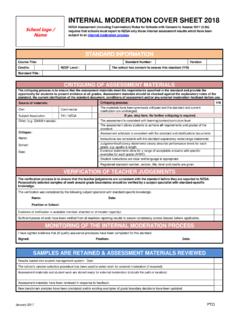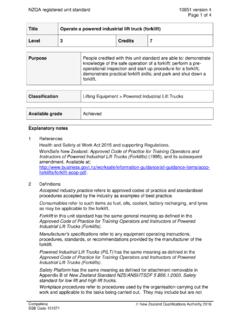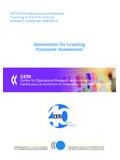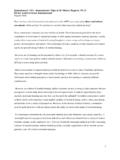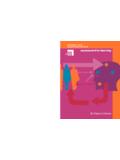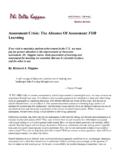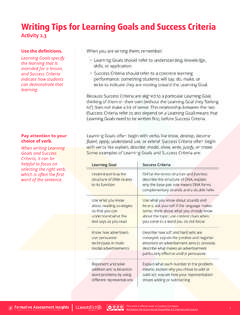Transcription of LEARNING AND ASSESSMENT - nzqa.govt.nz
1 LEARNING ANDASSESSMENTFOR THE NATIONALQUALIFICATIONSFRAMEWORKA GUIDE TOASSESSMENT New Zealand Qualifications Authority 2001 All rights reserved. No part of this publication may be reproduced by anymeans without the prior permission of the New Zealand 0-90892751-7iiLEARNING AND ASSESSMENTI ntroduction to 2001 editionLearning and ASSESSMENT was first published in 1996. It has been indemand ever since and reprinted many times in its original format. The2001 edition retains the text of the original. The photographs have beenomitted to reduce costs and the original Foreward was no longer are delighted and a little surprised that there is sufficient demand fora reprint five years on.
2 When we were researching for LEARNING andAssessment late in 1995 only 40,000 learners were being assessed for theFramework. There were 4,800 registered unit standards and 109 nationalqualifications. Only 414 providers were accredited and 16 ITOs were ableto register workplace assessors. Sixty schools were trialling mathematicsand geography was little practice of any kind, let alone proven successfulpractice, on which to base advice to assessors. Our scenarios and casestudies in computing, small business management, commercial fishingand economics reflected hope and expectation rather than are now 626,000 learners registered on the Framework; about200,000 of them were active in 2000.
3 More than 770 National Certificatesand National Diplomas are available and 15,800 unit standards covervirtually all areas of LEARNING and industry. In 2002, students who wouldhave been sitting School Certificate will become Framework learnersthrough the National Certificate of Educational Achievement (NCEA).Our 1996 publicity for LEARNING and ASSESSMENT said "the big change ishow we think about evidence". (In fact the intended title was Consideringthe Evidence.) The term is now common usage among teachers andassessors and we have even heard learners talk about producing evidencefor other words, the Framework is a successful working reality. Itsimpact has been acknowledged by politicians, employers, educators andresearchers.
4 If we were writing LEARNING and ASSESSMENT now theproblem would be to adequately reflect the huge diversity of styles oflearning and approaches to ASSESSMENT the Framework has served and ASSESSMENT has its limitations. It will be (or should be)too basic for many involved in Framework ASSESSMENT . But it is alwaysgood to get back to basic concepts occasionally. LEARNING and AssessmentLEARNING AND ASSESSMENTiiiAssessment for the Qualifications Frameworkis primarily for teachers and tutors within LEARNING providers, not forworkplace assessors. But much of the demand for the publication hascome from industry assessors. It does not describe the subtleties ofassessment, whether to assess at element or performance criteria level, , we have not added or removed material.
5 Feedback confirmsthat there is still a need for introductory guidance on how to use unitstandards. In recent months we have often referred to LEARNING andAssessment to find the right way to explain something and have found thatall definitions, comments and advice remain encourage readers to visit the NZQA website ( )for more recent and complementary material. For example, we havepublished descriptions of the ASSESSMENT of prior LEARNING , best practice inassessment and moderation, and current approaches to moderation. TheNCEA has been developed since Leaning and ASSESSMENT was written. Avisit to the NCEA website ( ) will show readers theextent to which ASSESSMENT for NCEA is similar to ASSESSMENT for thewider always, we welcome your comments and LennoxNZQA CommunicationsJune 2001ivLEARNING AND ASSESSMENTA ssessment for the Qualifications FrameworkAbout this guideEARNING ANDASSESSMENTis for tutors, teachers, trainers, lecturers and assessors in all educational institutions that are assessing for theNational Qualifications guide tackles one aspect of the Qualifications Framework: theassessment process.
6 It explores the basic thinking and principlesunderlying ASSESSMENT for the Framework. You can see how to selectappropriate ASSESSMENT activities and consider how this kind of assessmentimpacts on LEARNING and ASSESSMENT draws your attention to ASSESSMENT you assess you deal with evidence of a learner s performance. It iswell known that the Qualifications Framework uses standards-basedassessment. But first you have to collect the evidence. You are invited tostep back and take a fresh look at the ASSESSMENT process, how you collectevidence and how you evaluate guide has been arranged so that you can choose whether to startfrom the beginning and work through to the end or to focus on particularsections.
7 To find your way, you can look at the chapter headings and thequestions summarising each and ASSESSMENT is designed to be read in all educationalinstitutions so its language is generalised. LEARNING programmes are anyplanned chunks of LEARNING that could include ASSESSMENT against unitstandards courses, units of study, modules and the like, regardless oflength or the number of learners involved. Learners are the people whoare being assessed some of them will not be students in the traditionalsense. ASSESSMENT generally means ASSESSMENT for nationalqualifications. The guide is addressed to you as the teacher or tutor orlecturer where a generic term is needed, we refer to you as the assessor.
8 A general guide like this can go only so far. As unit standards becomeavailable in your own field you will be able to apply the generalapproaches discussed in LEARNING and ASSESSMENT to unit standards thatyou will be working with. Examples used in this publication draw on theactual unit standards that were available at the time of publication. TheQualifications Authority welcomes your comments on this publication andthanks those who contributed to its AND ASSESSMENTvAssessment for the Qualifications FrameworkLviLEARNING AND ASSESSMENTA ssessment for the Qualifications FrameworkContentsKey points1 ASSESSMENT for the Qualifications Framework1 What s new about this approach?
9 What about existing ASSESSMENT practices?What is evidence and how is it collected?How is evidence evaluated?What is good ASSESSMENT ?2 LEARNING Programmes and Unit Standards9 What is a unit standard?How do unit standards relate to LEARNING programmes?How much do I assess?How are unit standards used?What about qualifications?What is moderation?3 Sources of Evidence19 Where can evidence come from?What about RPL?Evidence of prior from LEARNING from specially created ASSESSMENT of current external diverse Developing ASSESSMENT Activities31 How do I choose activities that will provide appropriateassessment evidence?Can we separate skills, knowledge and understanding?
10 How can I integrate ASSESSMENT ?What about reassessment?Creating an ASSESSMENT do I ensure that ASSESSMENT is fair? LEARNING AND ASSESSMENTviiAssessment for the Qualifications Frameworkvii5 Evaluating the Evidence43Is the evidence worth considering?Does the evidence indicate that the standard has beenachieved?Following up the do I decide that I have sufficient evidence?Sufficiency some ASSESSMENT and the Learner49 What is the learner s role in the planning?Some case The qualities of good How do you read a unit standard?3 External results describe what learners know, understand and can about a learner s abilities can be collected in a variety of situations and evaluated against ASSESSMENT for theQualifications FrameworkASSESSMENTfor the National Qualifications Framework is conductedby accredited organisations.
